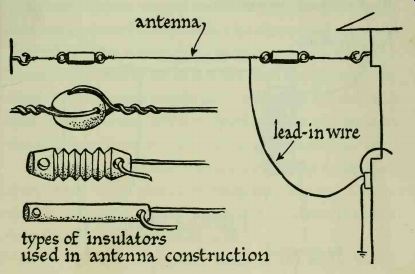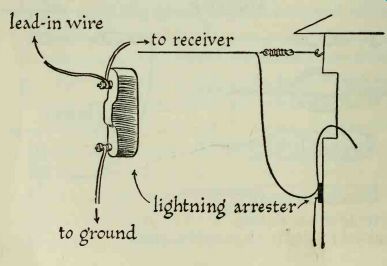An antenna, or aerial, is a conductor that intercepts broadcast electromagnetic waves. Every radio receiver must have an antenna. Commercially built receivers usually have small loop or coil antennas concealed within the cabinet.
A good antenna will improve the performance of any radio. This is particularly true of the low-powered receivers we are going to build. Any substance that is a good conductor will make a good antenna. The simplest antenna is a long length of wire connected to the receiver.
Although any wire can be used, most antennas are made of stranded copper wire. Your antenna should be erected as high as possible and kept away from power lines and from touching trees, buildings, or tin roofs. The longer it is, the more efficient it will be. If possible, make your antenna at least 100 feet long. If that is not feasible, a shorter wire (at least 25 feet long) will have to do.
Antenna wire may be bare or insulated.
Fasten each end of the antenna wire to a porcelain insulator. Pass the wire twice through one of the ends in the insulator, then wind it back on the antenna itself, using at least 10 turns.
Suspend the antenna between your building and an other building, a tree, or post. This can be done by running a wire from the free end of each insulator to a firmly anchored screw eye or screw hook, as shown in the illustration.

---------
The end of the antenna near your house should be connected to a lead-in wire, which then goes to the antenna terminal of your receiver. Make the connection by scraping both ends, then twisting them tightly together. A few turns of electrician's tape over the joint will prevent it from weathering. Any insulated wire makes a good lead in.
The illustration shows a typical long-wire antenna system which makes use of a device known as a lightning arrester. This arrester protects the receiver in case the antenna is struck by lightning, and it should be part of every outdoor antenna installation. It will sidetrack a discharge of lightning directly to ground instead of permit ting it to reach the receiver.

---------------
The arrester has two terminals. The lead-in wire is connected to one of them, from which it goes directly to the receiver. Another length of wire is connected to the other terminal; the other end of this wire is clamped to a ground rod. This is a copper-plated steel rod from four to eight feet long that is driven into the ground next to the building. Ground rod and clamp sets are sold by radio supply stores.
Any type of metal pipe four to eight feet long driven into the ground makes a satisfactory ground rod. The ground wire can be fastened to it with a ground clamp which may be bought at any electrical supply store.
Many experimenters, particularly those who live in apartment houses, cannot erect an outside antenna. In this case one can be improvised by connecting a wire to a metal window screen, a bedspring, or any other large metal object that is not in contact with the ground. Reception can often be improved by using just a few feet of wire as an antenna. A short length of wire can even be dangled from a window in order to get it out of the way.
Make a hidden indoor antenna by tacking a length of wire on top of the picture molding in your room. Or, try running some fine magnet wire around the baseboard; it is so thin as to be practically invisible.
A ground is a connection made to the earth, either directly or indirectly. Most of the receivers described in this guide require ground connections.
The best ground is made by attaching a wire to a cold water pipe. Scrape a small section of pipe until all paint is removed and the metal is bared. Pass a few turns of wire around the clean area and twist it tight.
A ground can also be made by driving a metal rod or pipe into the earth; it should be at least 3 or 4 feet long.
If you cannot hook up to either a cold-water pipe or an outside ground, try attaching a wire to a radiator pipe.
This is definitely a second choice, to be used only when a proper ground connection is not available.